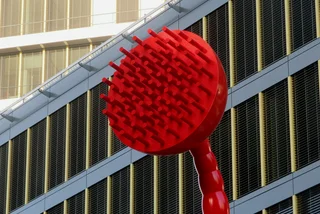The full glory of the incomplete Art Nouveau bridge linking Prague’s Pařížská Street with Letná Park is set to take effect in the coming years.
The original designs for Čechův most called for real flames to rise from torches held by two allegorical bronze statues on the pillars on the western side, and spouts of water to spew from the mouths of the three-headed hydra on the eastern side. These effects will finally be seen for the first time over a century after the bridge opened.

“Although Čechův most is the shortest road bridge in Prague, it has remarkable artistic value. The revitalization of the decorative effect equipment will underline its aesthetic perception, and the panorama of the bridge will be even more impressive,” City Councilor Jan Chabr, responsible for property, said.
“At the same time, it will mean a return to the old days, and Praguers will be able to remember the time when the first steel bridge over the Vltava was built,” he added.
Čechův most, the city’s only steel-frame arched bridge, was built in 1905–08, based on a design by Jan Koula and Jiří Soukup. Sculptors Ludvík Herzl and Karel Opatrný designed the torchbearers, while the hydras with the municipal seal are by Luděk Wurzl. It is now a protected landmark.

Renovation of lighting and effects systems will be done by the city company Technologie hlavního města Prahy (THMP).
“From the surviving information, it seems that the sculptures were to be fitted with pipes for water and gas distribution. At the same time, however, it is clear that this plan was never implemented. Today, we are going to revive this unique monument and provide everyone with an unforgettable spectacle,” Tomáš Jílek, chairman of the board of directors of THMP, said.
The lighting, gas, and pressurized water will be equipped with their own control systems, including the possibility of remote monitoring and control from the THMP headquarters. The city company will build on its extensive experience in thematically colored lighting at the Petřín Lookout Tower, which is now also controlled remotely.

The work needed to revitalize the lighting and effects systems will be started by THMP in the spring. Completion will depend on the progress of the restoration work on the statues. The planned modern lighting technology will be installed when the restored statues are returned.
The 169-meter-long and 16-meter-wide bridge currently has tram tracks in two directions. It was named after Czech writer Svatopluk Čech, who died in 1908, the same year the bridge opened. He is known for his poems on Slavic unity and social problems, as well as satirical novels. During the occupation of Bohemia by the Nazis the name of the bridge was changed to Mendelův most, after biologist Gregor Mendel.

While the renovation will complete part of the plan for the bridge, another part will never be fulfilled.
When you now stand on Pařížská Street and look north, currently you see the cliffs of Letná Park, with the base of the destroyed statue of Stalin. The base is now topped by the Metronome, technically called Time Machine (Stroj času).
Architect Jan Koula, who helped design the bridge, envisioned a wide avenue, following along a straight line from Pařížská Street across the new Čechův most and straight through the Letná cliffs all the way to Bubeneč. Koula saw the never-built monumental avenue as a natural extension of the bridge.

His 1907 plan would have meant removing a massive chunk from the middle of Letná’s rocky cliffs. Sketches and models show a massive two-sided colonnade cutting through the cliffs, covered by a walkway on top, and lots of ornate sculptures. The statue-capped columns on the top of the bridge would have echoed similar details in the proposed colonnades.
While this plan was never put into effect, a detailed plaster model can be found in the National Gallery in Prague’s permanent exhibition at Veletržní palác.












 Reading time: 3 minutes
Reading time: 3 minutes 



































